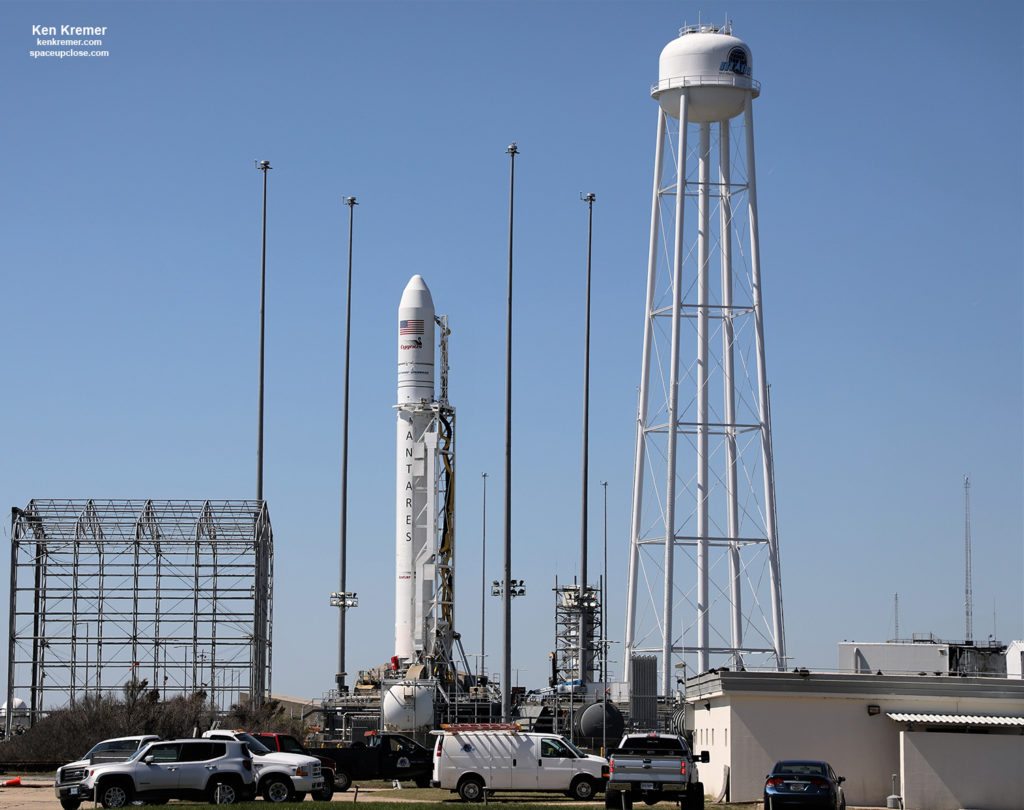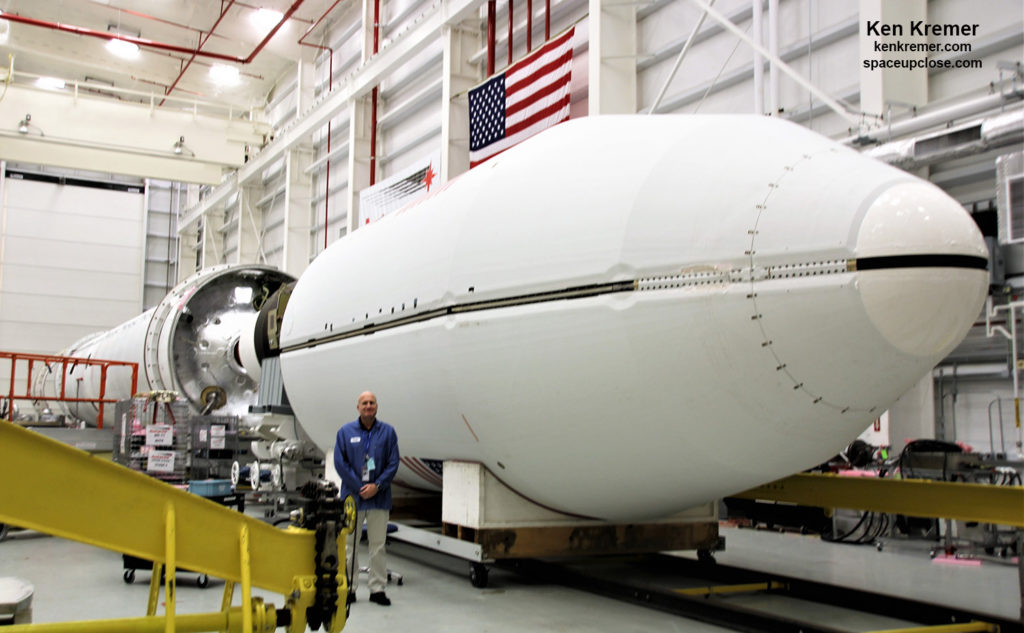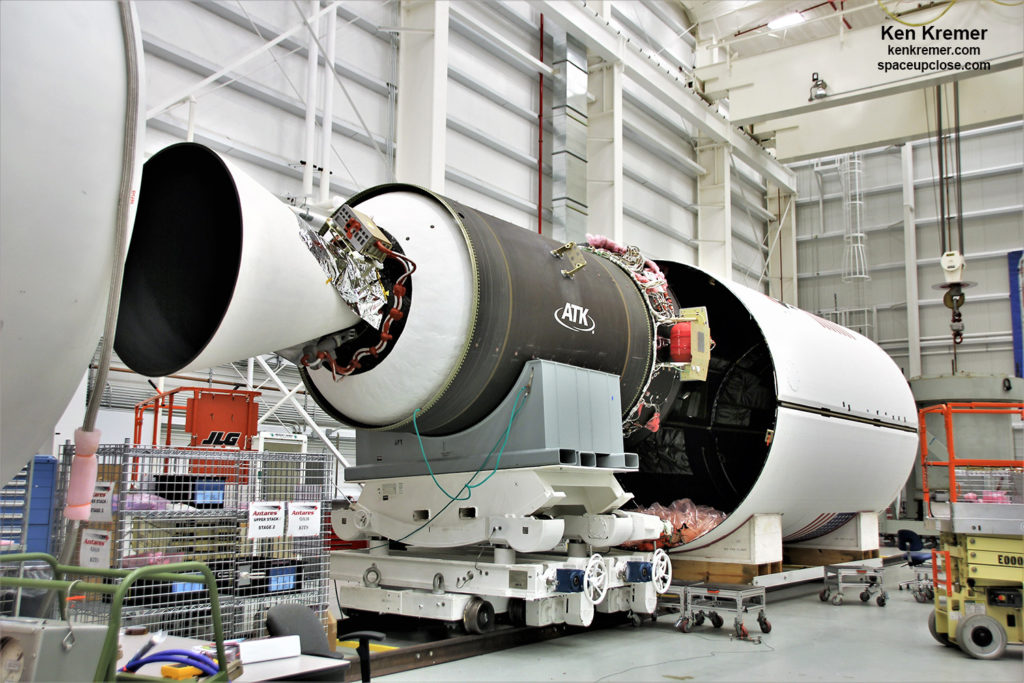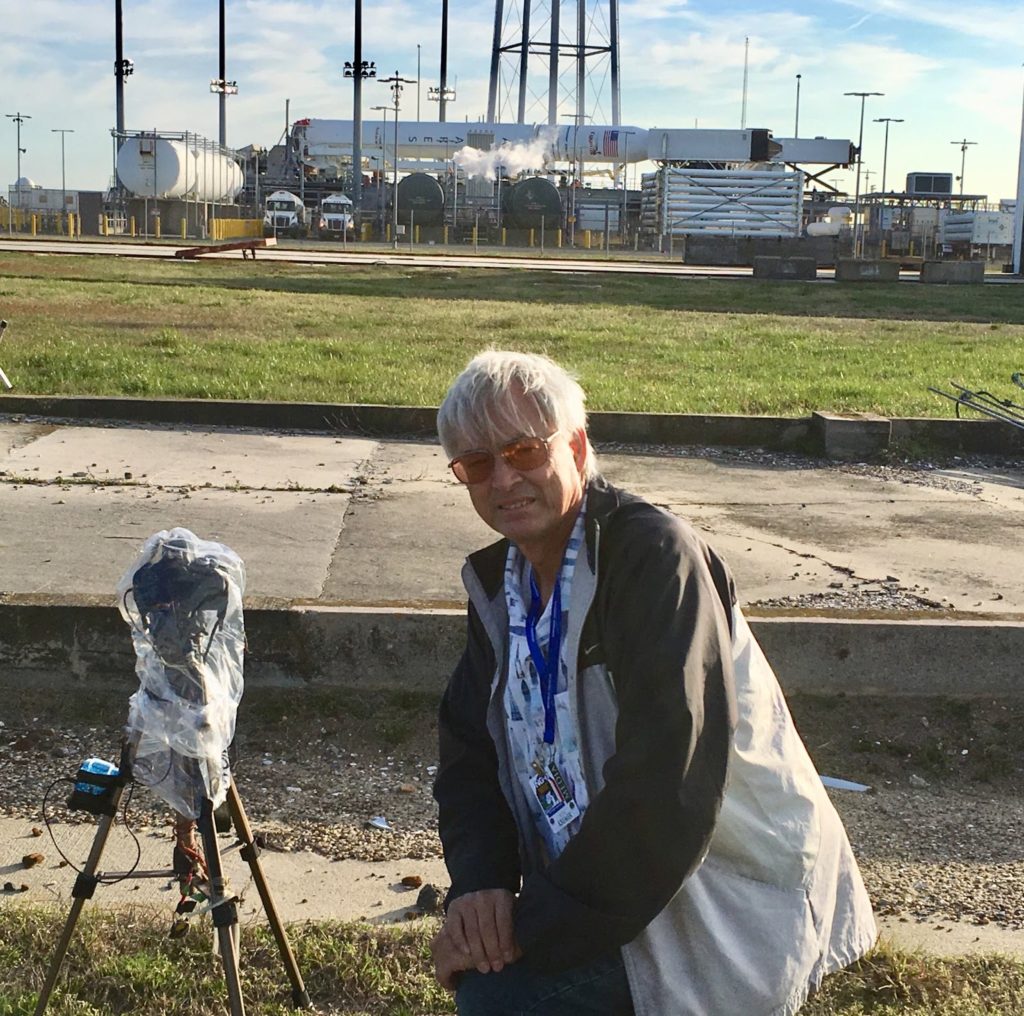Ken
Kremer — SpaceUpClose.com &
RocketSTEM – 16 April 2019
NASA
WALLOPS FLIGHT FACILITY, VA – Everything
remains on track for this week’s launch of Northrop Grumman’s next private Antares rocket hauling the company’s next unpiloted commercial Cygnus
cargo ship loaded with almost 4 tons of science and supplies to the
International Space Station (ISS) from NASA’s Wallops Flight Facility along
Virginia’s Eastern Shore on Wednesday, April 17.
40 micetronauts are
also loaded aboard Cygnus for the first time as a result on upgraded capabilities
introduced for the first time this mission.
The weather outlook is
excellent and large crowds are expected for the sure to be spectacular overnight
blastoff Wednesday afternoon.
NASA’s commercial
partner Northrop Grumman
is scheduled to launch its Antares rocket in the upgraded 230 configuration carrying
its Cygnus cargo spacecraft to the International Space Station at 4:46 p.m. EDT (2046 GMT) Wednesday, April 17 from seaside
Launch Pad 0A at the Virginia Space Mid-Atlantic
Regional Spaceport (MARS) at NASA’s Wallops Flight Facility in Virginia.
In anticipation
of a launch, Northrop Grumman workers rolled Antares to the launch pad Monday morning
April 15, approximately 1 mile (1.6 km) from the Horizontal Integration Facility
(HIF) to pad 0A at Wallops.
The
Cygnus NG-11 commercial resupply cargo ship is loaded with nearly 7,600 pounds (3,440 kilograms) of science experiments, research, gear, crew
supplies and hardware, for Northrop Grumman’s 11th commercial resupply
NASA-contracted mission.
About two-and-a-half hours after launch, an
automated command will initiate deployment of the spacecraft’s solar arrays.
Full deployment will take approximately 30 minutes.
Check out our Space
UpClose gallery of launch pad imagery with the rocket both vertical and
horizontal as workers completed the stocking of ‘late load’ items starting Tuesday
evening.
The countdown will begin 5 hours before launch at 11:46 a.m. ET (1546 GMT).
You can watch the launch live on NASA TV and
the agency’s website.
The launch window opens at 4:46 p.m. EDT and
extends for 5 minutes total until 4:51 p.m. EDT.
Launch coverage
and commentary on NASA TV and streaming online at nasa.gov/live will begin at
4:15 p.m. EDT April 17. The agency will air the launch as well as
briefings preceding and following liftoff on NASA Television.
Weather permitting the
Antares launch will be visible to tens of millions of residents in along the US
Easy Coast especially in the Atlantic and Northeast regions.
“The launch may be visible, weather permitting, to residents up
and down the East Coast of the United States,” says NASA.
And superb weather
conditions are forecast for April 15 with a 95% chance of favorable conditions.
Here is a visibility
map from NASA:
upgrade to Cygnus capabilities, Northrop Grumman is introducing the capability
to add ‘late load’ items – such as allow time-sensitive science
experiments. For the first time these late load items will be loaded into
Cygnus just 24 hours before liftoff.
This is being demonstrated for NG-11. After rolling out Monday,
the rocket was lowered Tuesday evening around 5 p.m. ET during our media remote
camera setup.
Technicians then moved the mobile clean room snugly up to the
Cygnus nose cone and open it via the newly added ‘pop top’
‘Approx. 140 kg of late load items are being added and it will
take about 7 hours to complete the task of stocking Tuesday evening through about
midnight and raise the rocket back to vertical,’ Frank DeMauro, Vice President and General Manager, Space Systems,
Northrop Grumman, told Space UpClose.
Previously, all cargo had to be loaded about four days prior to
launch. This new capability enabled the addition of the 40 mice for the first
time ever to Cygnus for example.
Last fall Space UpClose
took an exclusive UpClose tour of this NG-11 rocket and the last one NG-10 as
the two Antares rockets being processed side by side inside the Northrop
Grumman rocket assembly factory at Wallops known as the Horizontal Integration
Facility (HIF).
Enjoy a sampling here.
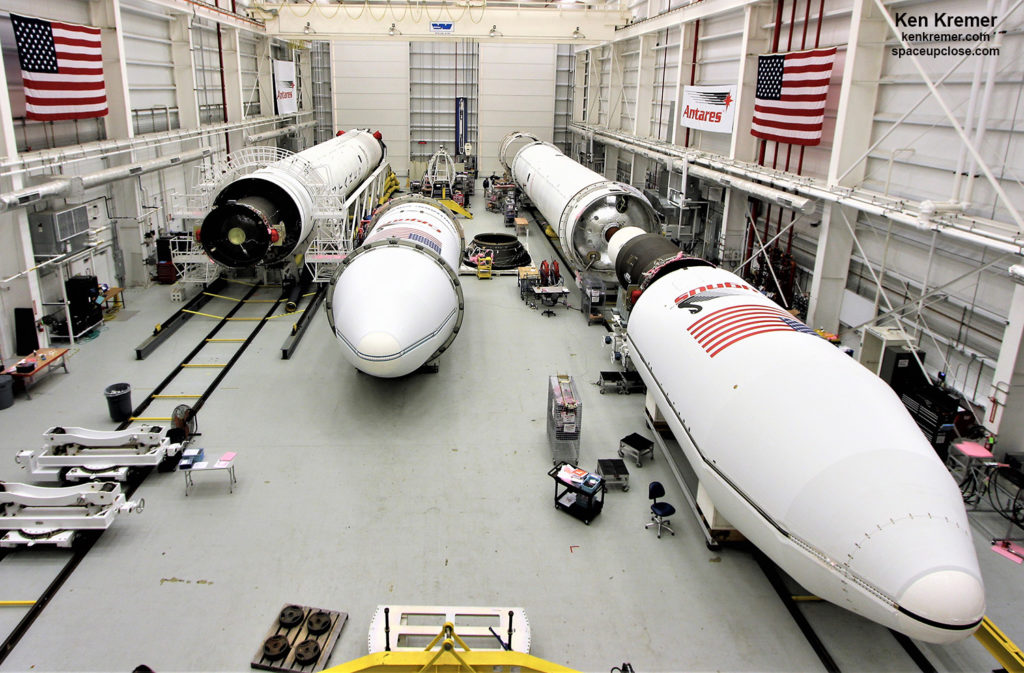 |
|
Exclusive prelaunch view of Antares NG-11
rocket inside the Northrop Grumman Horizontal Integration Facility at NASA Wallops. Credit: Ken Kremer/kenkremer.com/SpaceUpClose.com |
 |
|
Exclusive prelaunch view of Antares NG-11
rocket inside the Northrop Grumman Horizontal Integration Facility at NASA Wallops. Credit: Ken Kremer/kenkremer.com/SpaceUpClose.com |
Cygnus will deliver
vital equipment, supplies and scientific equipment to the space station as part
of Northrop Grumman’s Commercial Resupply Services-1 (CRS-1) contract with NASA
– totaling 11 cargo flights.
“NG-11 is the mission under
the CRS-1 contract,” said Kurt Eberly Antares vice president at Northrop Grumman. NG-10 last fall was the “next to last.”
Here are some highlights of space station
research that will be facilitated by investigations aboard this
Cygnus – from NASA:
Advanced Colloids
Experiment-Temperature-10 (ACE-T-10) investigates the growth, microscopic dynamics,
and restructuring processes in ordered and disordered structures such as
colloidal crystals, glasses, and gels. Colloids provide ideal models for
researching the fundamental principles of internal organization in such
structures because their particles are small enough to engage in relevant
phenomena, yet large enough for detailed study. Colloidal system interactions
vary precisely with temperature and undergo a variety of transitions including
crystallization and glass formation. Conducting the study in microgravity
removes the effects of gravitational stresses.
Bio-Analyzer, a Canadian Space Agency (CSA) instrument, enhances
life sciences research capabilities on the space station. It performs on-orbit
detection and quantification of cell surface molecules on a per cell basis,
including blood cell counts, and assesses soluble molecule concentration in a
liquid sample such as blood, saliva, or urine. Part of the Life Science
Research System (LSRS), the Bio-Analyzer uses just a few drops of liquid – a
finger prick versus a standard blood draw, for example – and eliminates the
need for freezing and storing samples.
Recent research suggest
links between cardiovascular health risk, carotid artery aging, bone metabolism
and blood biomarkers, insulin resistance, and radiation. Data also indicate
accelerated aging-like changes in many astronauts on the space station,
including changes to their arteries. The Space Environment Causes Acceleration
of Vascular Aging: Roles of Hypogravity, Nutrition, and Radiation (Vascular Aging) looks at these changes using artery
ultrasounds, blood samples, oral glucose tolerance tests, and wearable sensors.
It is one of three related Canadian experiments
studying the effects of weightlessness on the blood vessels and heart.
A small robot takes on
big jobs aboard the space station. The free-flying Astrobee can help scientists and engineers develop and
test technologies for use in microgravity, give astronauts a hand with routine
chores, and provide additional eyes and ears for flight controllers in Houston.
Building on the success
of SPHERES, NASA’s first-generation free-flyer, Astrobee,
operates either in fully automated mode or under remote control from the
ground. It can run longer and requires no supervision from the crew, freeing up
more astronaut time for research. It also opens up more opportunities to
experiment and test capabilities with lower risk. Astrobee is a product of the
NASA Game Changing
Development Program.
Chaffee, will arrive at the space station Friday, April 19. At about 5:30 a.m.,
Expedition 59 NASA astronaut Anne McClain will grapple the spacecraft using the
station’s robotic arm. She will be backed up by David Saint-Jacques of the
Canadian Space Agency. NASA astronaut Nick Hague will monitor Cygnus systems
during its approach. After capture, ground controllers will command the
station’s arm to rotate and install Cygnus on the bottom of the station’s Unity
module.
Live coverage of the grapple will begin at 4
a.m. and Cygnus installation coverage will begin at 7 a.m. April 19.
The Cygnus spacecraft is scheduled to remain at
the space station for about 3 months until July 23, 2019, when it will depart
the station, deploy NanoRacks customer CubeSats, and then have an extended
mission until December 2019 before it will dispose of several tons of trash
during a fiery reentry into Earth’s atmosphere.
This will be the final mission under Northrop
Grumman’s CRS-1 contract with NASA before starting the CRS-2 contract missions
in the fall of 2019. Under Northrop Grumman’s Commercial
Resupply Services contract, the company will fly 11 missions.
Watch for Ken’s continuing
onsite coverage of NASA, SpaceX, ULA, Boeing, Lockheed Martin, Northrop Grumman
and more space and mission reports direct from the Kennedy Space Center, Cape
Canaveral Air Force Station, Florida and Wallops Flight Facility, Virginia.
Stay tuned here for Ken’s continuing Earth and
Planetary science and human spaceflight news: www.kenkremer.com –www.spaceupclose.com – twitter @ken_kremer
– email: ken at kenkremer.com
Dr. Kremer is a research scientist and journalist based in the
KSC area, active in outreach and interviewed regularly on TV and radio about
space topics.
Ken’s photos are for sale and he is available for lectures and outreach events
 |
|
NASA and Northrop Grumman Antares Cygnus NG-11 prelaunch mission
briefing on April 16 prior to planned April 17, 2019 launch from NASA Wallops, VA. Credit: Ken Kremer/kenkremer.com/SpaceUpClose.com |


